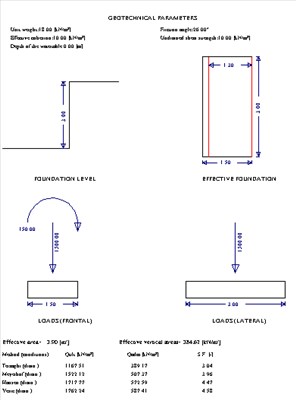Your single point of reference for all your Geotechnical Inquiries
Ce.Ca.P.
Ce.Ca.P. is a complete package for the analysis and design of foundations; because of its completness, flexibility ad user-friendliness it is a fundamental instrument for any kind of geothecnical project.
To calculate the bearing capacity of foundations, the following methods can be used: Terzaghi, Meyerhof, Hansen and Vesic. Such methods are based on different hypotheses regarding failure modes, and it is therefore interesting to compare the different results.
Normally, the allowable bearing pressure is determined for a given shape (square, rectangular, circular or strip) and stratigraphy.
The safety factor under effective load conditions is determined as the ratio between the ultimate bearing pressure and the effective vertical stress.
It is possible to determine the settlement of foundations that result from normal loads and from moments.
The calculation is performed at the most significant points and the rotations due to differential settlement are therefore determined also.
The settlement can be determined for square, rectangular, circular or strip foundations.
The use of numerical methods allows one to determine immediate elastic deformation and the long term effects of consolidation separately.
The program allows one to group together several described individually foundations and to evaluate the effect of the overloads induced by surrounding foundations.
This option allows one to analyse more complex cases, like the influence of the neighbouring foundations, foundations of any geometry and foundations on heterogeneous materials. Due to the flexibility of the numerical approach, it is possible to perform the calculations with the most frequently used theories (Boussinesq, Terzaghi or Skempton).
The bearing capacity of small, middle or large diameter foundation piles can be determined in stratified, coherent or incoherent soil, in drained or undrained conditions.
Different formulae are used for driven piles (in steel or concrete) and for drilled piles, thereby taking the effects induced by drilling or pile driving into account.
Calculations to obviate the risk of seismic disturbances are also possible.
The formulae and experimental curves proposed by different authors are used, thus allowing the results obtained from different methods to be compared.
Point and skin resistance (whose sum constitutes the ultimate pile capacity) are determined separately, and the safety factor is thus determined for project loads.
The program performs the calculations for different families of diameters and lengths, and the resultant chart allows the choice of the combination of the optimal diameter-length from an economic point of view.
Italy











